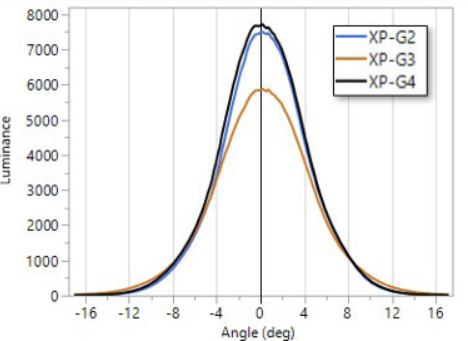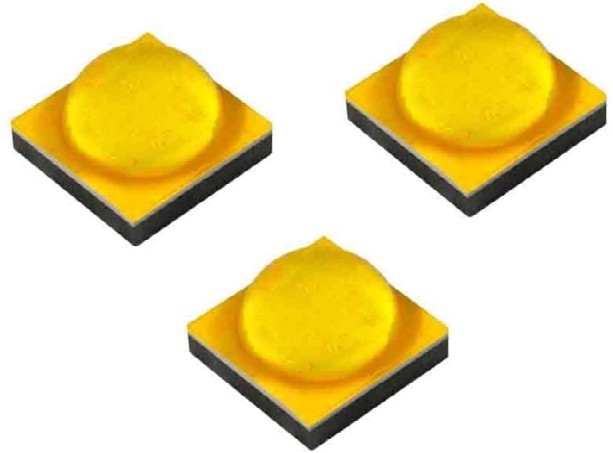According to analysts at Fortune Business Insights, the global LED lighting market is currently experiencing double digit year-on-year growth – with a 19.2% compound annual growth rate (CAGR) projected to continue between now and the end of the decade. This equates to it having an annual worth close to $300 billion by the end of that period. To get a share of the lucrative opportunity that this represents, LED manufacturers need to develop products that are capable of pushing the performance envelope and offering clear differentiation to end users.

Figure 1: Luminance vs viewing angle of a narrow beam spot optic projection shows the beam shape and intensity similarities between XP-G4 and the prior XP G2 family and improvements compared to the XP-G3 family
By boosting performance characteristics, new LED generations have been able to bring about a marked reduction in the number of devices needing to be installed into lighting fixtures. As a consequence, there has been a lowering of overall fixture costs, while simultaneously making them more compact too. Innovations have resulted in elevated maximum drive current figures and lower thermal resistance values, as well as presenting a wider selection of corelated colour temperature (CCT) and colour rendering index (CRI) options. Furthermore, use of optics that are specifically suited to particular application scenarios has brought considerable rewards with it.
In any industry sector, when a well-established product line has dramatic improvements applied to it, current users as well as newcomers are going to take notice. High-power LEDs are no exception in this respect – with the upgrading of existing designs and brand new system implementations both benefitting as a result.
The LED revolution
Initially introduced in 2009, the original Cree LED XLamp XP-G LEDs represented a breakthrough in performance and helped to kickstart a new era in solid-state illumination. Producing up to 400lumens of light output at 1A current levels and over 130Iumens/W at only 350mA, these emitter devices were up to 43% brighter and 53% more efficient than their predecessors.
The XLamp XP-G2 LEDs that followed a couple of years later increased the lumen output that could be supported up to 20%. When the XLamp XP-G3 devices arrived in 2016, a further 31% lumen output increase was realised, along with an 8% higher lumen/W figure. Now, with the announcement of the XLamp XP-G4 emitter products, the bar has been raised even further.
The devices in this new LED family can deliver 75% more lumens than their XP-G2 counterparts and have an even lower thermal resistance of 1.3°C/W. Wide acceptance of these LEDs is being seen in outdoor lighting, portable lighting, indoor lighting and solar-powered lighting implementations. In addition to the benefits of their performance augmentation, sharing the same footprint as the original XP-G, XP-G2 and XP-G3, XP-G4 LEDs means that users are provided with a seamless upgrade path and shortened design cycles.
Making a difference
The advances encompassed within the XLamp XP-G4 LED products are based on utilisation of the latest raw material, packaging and chip technologies. Effective use of ceramic high-power LEDs in many directional lighting applications often means employing a one-to-one configuration with specialised optics provided. With a smaller light emitting surface (LES) and up to 69% higher intensity than previous generations, XP-G4 LEDs create tighter beam angles and higher candela values than were previously possible.
With the XP-G3 family (see Figure 1), there had to be a traded-off with luminescence to maximise efficacy and long-term operational reliability. In contrast, the XPG4 family introduces a highly optimised optical profile that has been designed to accentuate on axis light output and provide substantial enhancements over the previous LED family. This allows XPG4 devices to deliver a 41% increase in maximum light output compared to XP-G3 devices, reaching up to 1,130lumens.
Use of proprietary technology leads to better directing of the emitted light into a narrower, more uniform cone. This results in a view angle full width half maximum (FWHM) of 120° in neutral white. The narrowed emission, reduced spill light and well-defined LES makes the new LED family highly suitable for directional lighting deployments – such as spotlights, premium torch and sports stadium lighting.
A flat and smooth phosphor layer results in a superior colour-over-angle profile. In addition, a 70° cut-off dramatically improves coupling efficiency with secondary optics compared to competing high-power LEDs.
The new XP-G generation is available in CCTs ranging from 1800K to 6500K and CRI options of 70, 80 and 90. In addition to the applications already mentioned, other uses include architectural, entertainment and horticultural lighting.
Conclusion

Figure 2: Cree LED’s performance boosted XP-G4 emitter family
Demands for LEDs that possess heightened performance attributes are being witnessed across a multitude of industry sectors – and this is driving continued optoelectronics innovation. With more than 2 billion XLamp XP-G LEDs already shipped so far, the latest generation XP-G4 devices have been highly anticipated. These emitters have successfully brought together the heightened colour over angle and peak intensity levels associated with the XP-G2 family, plus the elevated levels of efficacy and reliability that came with the XP-G3 family. By making ongoing improvements to an established product offering that is widely deployed, while retaining the same footprint, luminaire designers will be able to make significant improvements their legacy designs or advance their future design concepts even further.
TrendForce 2023 Global LED Lighting Market Analysis
Publication dates: February 10, 2023; July 31, 2023
Language: Traditional Chinese/English
File format: PDF and EXCEL
Number of pages: 100 (in each publication)
If you would like to know more details , please contact:












